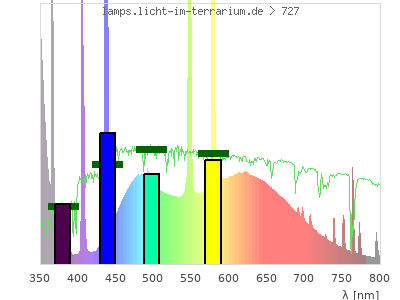
CCT:1019 6379K
CRI DC:1017 1.01E-2
CRI R01:1002 38.9 (6379K)
CRI R02:1003 45.1 (6379K)
CRI R03:1004 55.4 (6379K)
CRI R04:1005 51.1 (6379K)
CRI R05:1006 45.8 (6379K)
CRI R06:1007 41.2 (6379K)
CRI R07:1008 36.3 (6379K)
CRI R08:1009 30.3 (6379K)
CRI R09:1010 58.2 (6379K)
CRI R10:1011 36.2 (6379K)
CRI R11:1012 61.1 (6379K)
CRI R12:1013 61.1 (6379K)
CRI R13:1014 21.9 (6379K)
CRI R14:1015 70.9 (6379K)
CRI R15:1016 33.3 (6379K)
CRI Ra:1001 43.0 (6379K)
DC<5.4E-3:1018 false
Area (m²):1040 1.1946E-5
Illuminance (lux):1042 3.4982E2
Luminance (candela per m²):1044 3.4982E2
Luminous Flux (lumen):1041 4.1790E-3
Luminous intensity (candela):1043 4.1790E-3
Observer:1038 Photopic
Solid Angle (steradians):1039 1.0
Source:1037 FLMT09760
Device Source:1022 FLMT09760
Integration Begin:1023 280.00
Integration End:1024 800.00
Method:1025 Uses Simpson's Rule for integration.
Moles of Photons:1034 3.7392E-11
PAR uMoles/m²/sec:1036 5.9714E0
PAR uMoles:1035 2.4952E-5
Photons/cm²/sec:1032 5.3890E14
Total Photons:1033 2.2518E13
dBm:1030 -1.5681E1
eV:1031 5.9022E13
uJoule/cm²:1028 7.9160E1
uJoule:1026 9.4564E0
uWatt/cm²:1029 2.2631E2
uWatt:1027 2.7035E1
Colorimetry is the science to describe physically the human color perception. The wavelength range 380 nm - 780 nm is visible to humans and detected by three different photoreceptors. Many Reptiles see the range 350 nm - 800 nm and have an additional UV photoreceptor in their retina.

Whereas a spectrometer measures the intensity in every tiny wavelength interval resulting in thousands of individual intensities, the human eye only measures three intensities detected by the three cones. The same is true for the reptile eye with usually three or four photoreceptors. Effectively the detailled spectrum displayed above reduces to a much compacter bar graph displayed below. The photoreceptor sensitivites from these L-Cone, M-Cone, S-Cone, and U-Cone are used, they are chosen as an average of measured reptile photoreceptor sensitivity curves. The bar graph also shows as reference the intensity seen by the three or four photoreceptors for average sunlight (id 1).
From these three numbers the colour coordinate and the correlated colour temperature for humans are calculated using the CIE standard method. I adapted this concept to a "3 cone reptile (M,S,U)" and a "4 cone reptile (L,M,S,U)". I am sure, that this adaption to other colour spaces makes sense mathematically and this is also done in scientific research regarding colour vision of animals, however I have not seen calculation of colour temperatures for other animals in the scientific literature. Even if it is hypothetical, at least this shows, how arbitrary the colour temperature is, and that the colour temperature calculated for humans does not apply to reptiles. The colour spaces also show the colour coordinates of different phases of daylight ((ids
1,
338 –
451,
511 –
513 ), indicated by crosses, coloured in the appriximate colour perceived by a human.
|
Human (CIE) |
3 cone reptile |
4 cone reptile |
| Cone Excitation |

| 
|  |
| Colour Coordinate |
( 0.32 ; 0.31 ) |
( 0.32 ; 0.47 ) |
( 0.27 ; 0.23
; 0.34 ) |
| CCT |
6400 Kelvin |
6600 Kelvin |
5700 Kelvin |
| distance |
|
0.12 |
0.093 |
| colour space |
 |
 |
3-D-graph not implemented yet |
Vitamin D3 is produced by UVB radiation around 300 nm. 7DHC/ProD3 present in the skin is converted to PreD3 when absorbing an UV photon. PreD3 can be converted back to ProD3, to Lumisterol, or to Tachysterol when absorbing another UV photon or can be converted to Vitamin D3 in a warm environment.

This process prevents any overdose of vitamin D3 from UV radiation with a spectrum similar to sunlight. As a comparison the solar spectra at 20°(id:14) and at 85°(id:21) solar angle are shown.

The ratio of the two solarmeters 6.2 (UVB) and 6.5 (UV index) readings has proven a useful and very simply number to acess the spectral shape in the vitamin-d3-active region.
Effective irradiances are calculated for all ranges, actionspectra and radiometers currently present in this database.
The calculation method is a numerical implementation (Simpson's rule) of the formula

To learn more about calculating effective irradiances and radiometers I recommend this excellent report on UVB meters: Characterizing the Performance of Integral Measuring UV-Meters (pdf).
The numbers in the following tables can also be used to estimate certain (effective) irradiances from radiomer readings. Example: If the database lists
- range: UVB (US) = 13.8 µW/cm²
- radiometer: Solarmeter 6.2 = 19.6 µW/cm²
then any Solarmeter 6.2 reading multiplied with 0.7 (0.7=13.8/19.6) is an estimate of UVB irradiance for this specific lamp. If you do so, always make sure, that the calculated (effective) irradiance is valid. The calculated value is not valid, if the lamp's spectrum is not measured in the relevant range.

